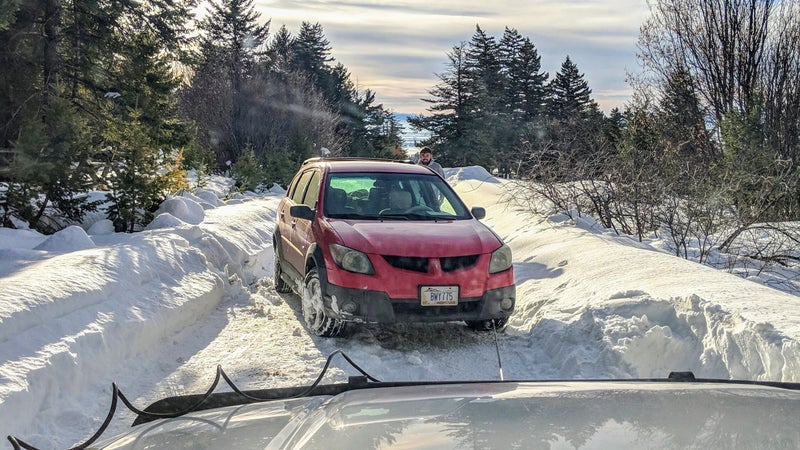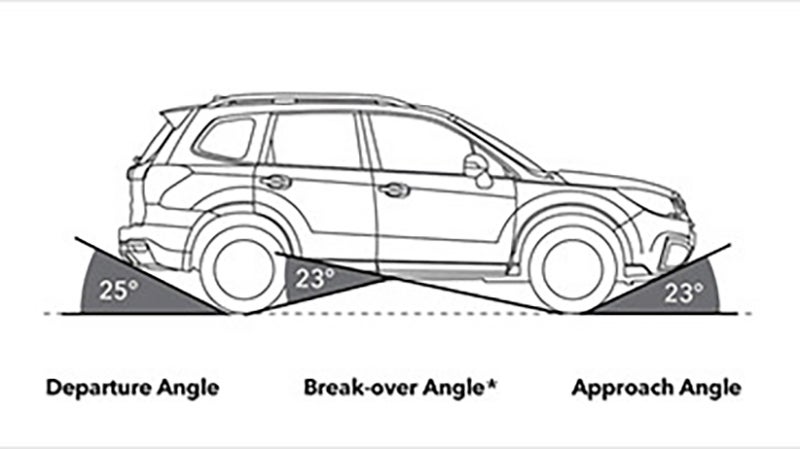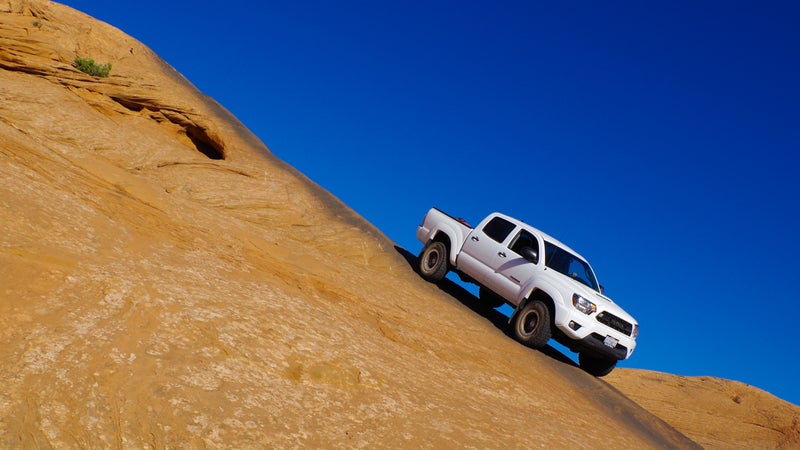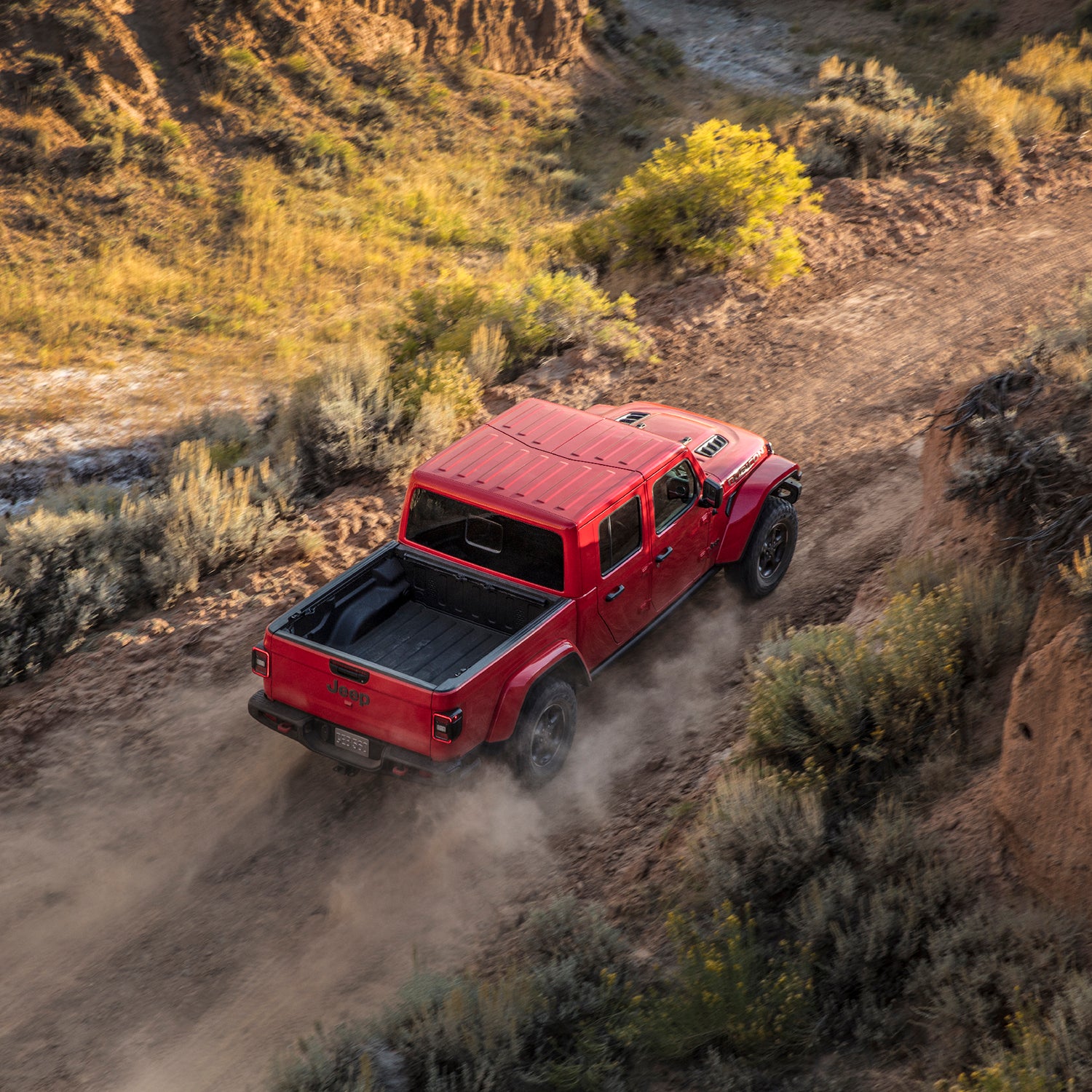One of the problems with shopping for a car or truck that can go off-road—colloquially known in these parts as adventuremobiles—is that the actual specifications that add up to genuine capability have become obfuscated by automaker marketing. Judging by the ads, both all-wheel drive crossovers and four-wheel drive trucks��are capable of the exact same feats, but in reality, one would get stuck before the other even broke a sweat. Why is that? And, how can you objectively determine the relative abilities of a vehicle simply by looking at its spec sheet? This is my attempt to explain it all in one place.��
It’s All About Traction

By definition, going off-road is the act of driving with limited traction. Roads are designed to provide smooth and consistent grip for your tires. The natural world wasn’t designed at all.
The first and most important thing you can do to gain traction off-road is use a good set of all-terrain or mud-terrain tires, and run those at an appropriate pressure. These are designed to grip surfaces like sand, rocks, wet grass, or mud, whereas road tires are only designed to grip pavement. The right tires for the job also help provide traction while braking and cornering, which the rest of the systems we’ll mention below cannot, making such��tires even more important.��
But which tires should you choose? If you drive a heavy��body-on-frame truck, then it’s hard to do better than the . Not only do they offer excellent grip off-road, but they remain reasonably well-mannered��on-road, too. But K02s��are designed specifically for those big trucks. So��if you drive a lighter unibody crossover, you’ll benefit from running a lighter tire, like the , which��offers most of the grip and puncture resistance of the K02 in a much more civilized package.��
Vehicles can then be equipped with systems designed to take advantage of the grip offered by those tires. The most obvious��is four-wheel drive (4WD or 4×4). When you have good on-road grip, your front and rear axles need to spin at different speeds when you go around corners. When you switch into 4WD, the differential that allows those axles to spin at different speeds is closed, locking their speeds together. This doubles your vehicle’s ability to take advantage of the grip achieved by your tires.��
In addition to the center differential that��4WD locks, a vehicle can also be equipped with locking differentials on one or both axles. Same deal: your inside and outside wheels need to spin at different speeds to safely get around on-road corners. By locking the speeds of the left and right wheels on an axle together, you’re ensuring��that the power being sent to that axle has to rotate both wheels at equal speeds��rather than sending all the power to the wheel with the least traction.��
In the good old days, it used to stay that simple. But then all-wheel drive (AWD) was invented, and carmakers realized that they could use it as a marketing tool to confuse and upsell unwitting car buyers on a technology they didn’t understand. These days��you see 4×4��badges on AWD cars��and AWD��badges on cars that are technically fitted with 4WD. Adding to the confusion, the capability of AWD systems varies wildly, and often the makers of AWD cars are utterly unable to communicate the ways in which their systems differ.��
I’m going to attempt an incredibly simplified explanation of all this, in order to foster a basic understanding of how AWD works (or doesn’t, which is mainly the issue here). Torque follows the path of least resistance within a drive system, so in an AWD car with three completely open differentials, all that torque will be sent to the wheel that’s��spinning fastest. That’s the wheel with the least grip, the one that’s stuck in mud, snow, or sand. Doesn’t sound terribly helpful, does it? It’s not, which is why manufacturers fit many AWD cars with a center differential capable of achieving some degree of lock, which then directs��power to both axles. Some high-performance AWD cars will also be fitted with some��sort of axle differential��which can also achieve some degree of lock, further increasing its ability to take advantage of your tires.��
Your takeaway: Tires are the easiest and most effective way to boost your vehicle’s ability off-road, no matter what you drive. AWD cannot offer the same capabilities as 4WD, but you can’t rely on marketing materials to determine which system a vehicle may be fitted with. Only 4WD vehicles with locking diffs on both the front and rear are capable of achieving maximum traction off-road.��
What Your Vehicle Can or��Can’t Make It Over

For the purposes of this article, let’s accept that we’re quantifying a vehicle’s ability off-road by its ability to avoid getting stuck. Nine times out of ten, you’re going to get stuck because you lose traction. In rare circumstances, you may get stuck��or find yourself unable to tackle an obstacle because you don’t have the clearance to do so.��
Clearance is another metric that gets extremely obfuscated by marketing. It’s common to see a vehicle’s ground clearance advertised, but when you think about it, outright ground clearance ends up being pretty irrelevant. Think about the last time you hiked a challenging trail: was it small rocks in the middle of the trail that presented the most challenge, or was it the larger rocks you had to climb up, over,��and down? It’s your vehicle’s approach, breakover, and departure angles, not its��outright ground clearance, that grant it the ability to overcome big obstacles.��
Approach is the angle between your front tires and the lowest point on your vehicle in front of them. Breakover is the angle from the bottom of either your front or rear tires��to where the opposite tire meets the lowest point on your vehicle. Departure is the angle from the bottom of your rear tire��to the lowest point behind it. In all cases, bigger angles are better.��
Car companies love to advertise ground clearance, because crossovers with independent suspension typically return more impressive numbers than trucks with solid axles. Without a big metal pole running between wheel hubs, I’m sure you can see why, if tire sizes are the same, a vehicle with independent suspension may have better ground clearance. But��simply by putting a tire onto an obstacle, the supposed advantage of ground clearance is made moot.��
The easiest way to improve your vehicle’s angles is by��fitting it with larger tires��and the taller suspension necessary to clear them. You may also be able to remove bodywork or accessories like bumpers and side steps��and replace them with more off-road-oriented items. But��some innate angle advantages are baked into certain types of vehicles. A two-door Jeep Wrangler, for instance, with its very short wheelbase, will inherently achieve a better breakover angle than its longer, four-door alternative. A vehicle with very short front and rear overhangs will inherently have superior approach and departure angles to one with longer overhangs.��
Your takeaway: Never lift an AWD crossover like a Subaru. Their angles are so poor that you can't really improve them, and whatever small��increase in��ground clearance a lift��nets you will achieve nothing but a ruined ride, handling, and fuel economy.��If you’re��serious about increasing the ability of a 4WD truck, then starting with a vehicle that has good angles to begin with will be easier and more effective than trying to lift a too long truck into the sky. Good luck getting a Sprinter van down anything but an easy dirt road.��
Gearing Does the��Hard Work

Gears multiply the influence an engine has over the wheels. The lower the gearing, the more the multiplication. Extremely low gearing is how you make it up very steep obstacles��and also how you descend them with control and safety. To achieve these extremely low gears��while retaining the ability to efficiently drive on-road, any good 4WD��vehicle will come with a low-range transfer case��which switches between normal��and very low gearing.��
Gears on your truck work just like they do on your bike. Throw either into its granny gear��and the gearing makes climbs easy. The only real difference is that low-range gearing on a truck makes it possible to use engine braking to control your speed on descents. Compared to your brakes, this doesn’t cause your suspension to dive, and it spreads the traction requirements for controlling your speed across all four wheels. Together, those abilities boost safety and control.��
Your takeaway: The greater the crawl ratio, the greater the abilities described here.��
What About Articulation?
Articulation is the ability of a wheel to travel up or down��relative to the wheel on the opposite side of the vehicle. Over uneven obstacles, a good amount of articulation will help you keep as many wheels as possible in contact with ground, which helps maximize traction, which you need for both ability and safety.��
Having said that, extreme levels of articulation aren’t really necessary for general off-road travel��and are mostly relevant to people playing in off-road parks. If you’re predominantly concerned with getting from A to B, then learning to tackle obstacles with as perpendicular a line of travel as possible will get you further than driving a vehicle with extreme articulation ever will.��
Your Takeaway: Worry about traction devices and your driving skills long before you worry about putting a wheel up on a concrete road barrier for an Instagram post.��
What Modern Electronics Can and Can’t Help With
https://youtube.com/watch?v=iwDq2Kwan6U
In addition to important on-road safety aids like stability and traction control, all manner of electronic systems are now advertising enhanced off-road abilities. Software is much cheaper and easier to develop and reproduce than mechanical components, and automakers must increasingly worry about the liability created by inexperienced drivers using their vehicles to do things they’re advertised as being capable of doing.��
Since modern vehicles already come with the ability to monitor individual wheel speeds��and control them with individual brake applications, it’s relatively simple for automakers to extrapolate that into the ability to replicate the function of locking differentials.��
Additionally, with technologies like drive-by-wire throttles, carmakers are able to offer truly dynamic switchable driving modes, which tailor a car’s performance to a wide range of conditions a driver may face. Whereas in the recent past, “snow mode” may have simply started the car out in second gear��and made sure traction control was switched on, now it may automatically switch in and out of 4WD as on-the-fly traction conditions dictate��while actuating individual brakes, not only to keep the vehicle pointed straight ahead��but also to accelerate��through a variety of slippery situations.��
On top of that, both Ford and Toyota offer semiautonomous off-road driving systems, which can take some of the skill out of brake and throttle applications while crossing difficult obstacles and automatically actuating all of the functions described above.��
Having said all that, none of this offers any additional mechanical ability beyond that created by locking differentials, low-range gearing, and good tires. It just makes the experience easier.��
Your Takeaway: Congrats, your fancy new car just endowed you with the ability to get stuck even further from pavement than ever before. If you plan to drive off-road regularly, take the time to learn the necessary skills to do so safely.��
What You Can and Should Change
More than any other use case��for vehicles, traveling off-road requires and rewards aftermarket modification. In fact, for many serious users, a stock vehicle is only viewed for its merits as a platform for modification��rather than for its abilities in stock form.��
Tires: The first upgrade��anyone should make. Just a good set of all-terrains alone will boost the capability of any vehicle, be it a front-wheel-drive econobox or a Humvee. Increasing the size of the tire will increase the height of obstacles it can roll over, but will reduce your effective gear ratio��while adding unsprung weight, which hurts your vehicle’s ride quality, acceleration, fuel economy, and braking.��
Suspension: If you want to substantially increase the size of your tires, you’ll need to fit taller suspension in order to clear them. Aftermarket suspension can also come with much higher-quality components, which can return much of your stock vehicle’s ride quality��and improve its ability to handle the harsher conditions suspension faces off-road.��
Differentials: Adding locking differentials to one or both axles will increase your vehicle’s ability to take advantage of the grip provided by your tires.��
Gearing: If you fit larger tires, you will need to change your differential gears in order to return performance, fuel economy, and control.��
Protection: If you hope to take full advantage of your vehicle’s angles, then you’re going to want to protect the bodywork. Off-road bumpers offer protection from bumps and scrapes while giving you the ability to mount accessories like winches, lights, and tire carriers. Rock sliders mount to the frame under your doors, protecting your vehicle’s body.��
Recovery Gear: Off-road, you’ll be traveling through unpredictable conditions a long way��from help. Equipment like a winch, shackles, a snatch strap, and recovery boards should be considered essential; they’re what enable you to get unstuck without hiking out to look for help.��
Lights: It’s nice to be able to see where you’re going at night, and stock equipment is no match for the insane levels of illumination that are available in the aftermarket.��
Racks:��These give you the ability to mount tools like a Hi-Lift jack or��fuel cans��while providing additional room for camping gear or sports equipment. Just be careful not to exceed your gross vehicle weight rating (GVWR), which you’ll find in the owner’s manual and can measure at any vehicle scale.��
Your Takeaway: Well-chosen modifications can add significant off-road ability��but will almost universally reduce on-road economy and comfort. Choose components as part of a cohesive build, taking��into account what you realistically need the vehicle to be able to do. An adventuremobile that’s awful to drive on the road is one you won’t enjoy using.��
It is only the equipment and capabilities discussed here that cumulatively create a car or truck capable of crossing challenging terrain. There is no magic pixie dust or marketing lingo that can change how any of this works. So, when you're shopping for a new adventuremobile, remember this article. It's my sincere hope that this knowledge can help you make more informed choices.


